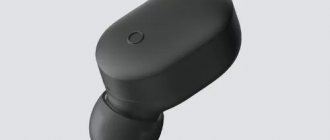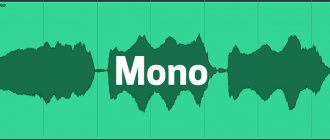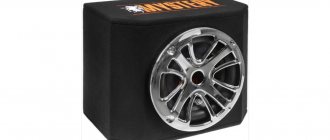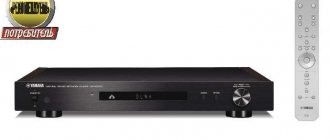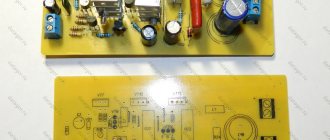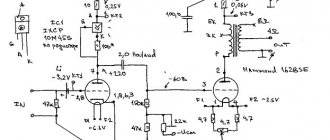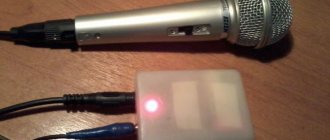SALES! TEMPORARILY OUT OF STOCK. TRIO KA-8700 Integrated stereo amplifier Japanese analogue of the European model Kenwood KA-801 Year of production: 1978 Price at the time of production was 120,000 yen (about $900) Excellent condition Dual mono - separate power supply, MOSfet in differential. cascades, at the entrance to the window. Sounds amazing...
Catalog: https://translate.google.com/translate?hl=ru&sl=ja&u=https://audio-heritage.jp/TRIO-KENWOOD/amp/ka-8700.html&prev=search
Additional photos: https://drive.google.com/drive/folders/0B6OBIfBnXv4XaXRxejdqb1JUeWs
Characteristic:
Rated power (phono → sp terminal, operation on both channels) 20 Hz - 20 kHz: 110 W + 110 W (8 ohms) 1 kHz: 150 W + 150 W (4 ohms) 115 W + 115 W (8 ohms) Common THD (8 Ω) phono → sp terminal: 0.015% (at rated power from 20 Hz to 20 kHz, volume - 20 dB) tuner, aux, tape → sp terminal: 0.015% (at rated power from 20 Hz to 20 kHz) 0.008% (at rated output power, 1 kHz) 0.008% (at rated output power 20 Hz to 20 kHz) Intermodulation distortion factor tuner, aux, tape → sp terminal: 0.003% (8 ohms, 60 Hz: 7 kHz = 4:1 at rated power) Frequency response tuner, aux, tape → sp terminal (direct DC off): DC ~ 450 kHz -3 dB tuner, aux, tape → sp terminal (direct DC off): 18 Hz to 450 kHz -3dB Output bandwidth (IHF) tuner, aux, tape → sp terminal: 5 Hz to 70 kHz (if the distortion factor is 0.03%, 8 ohms) Reset factor 100 or more (tuner, aux, tape → sp terminal, DC ~ 20 kHz, 8 Ω) Input sensitivity / impedance phono 1 (MM) → sp terminal: 2.5 mV / 50 kOhm phono 2 (MC) → sp terminal: 0.1 mV / 100 Ohm tuner, aux , tape → sp terminal: 200 mV / 50 kΩ maximum permissible input signal (1 kHz, strain rate 0.015%) phono 1 (MM) → rec out: 230 mV phono 2 (MC) → rec out: 9 mV background deviation RIAA 20 Hz - 20 kHz ± 0.2 dB SN (IHF-A) phono 1 (MM) → sp terminal: 90 dB phono 2 (MC) → sp terminal: 70 dB tuner, aux, tape → sp terminal: 105 dB Output level / impedance tape rec pin: 200 mV / 330 ohms Tone control (tuner, aux, tape → sp terminal) bass: ± 7.5 dB (100 Hz) triple: ± 7.5 dB (10 kHz) Volume control + 9 dB (100 Hz, tuner, aux, tape → sp terminal, Volume - 30 dB) Transient response Rise time: 0.8 µs (tuner, aux, tape → sp terminal) Slew rate: ± 150 V/µs (tuner, aux, tape → sp terminal) Power output Locking power switch: 2 systems, 100W Power switch without locking: 1 line, 400W Supply voltage AC 100V, 50Hz/60Hz Power consumption 280W (Electrical appliance and material control law) External dimensions Width 440 × height 153 × depth 407 mm weight 17.5 kg
Amplifier Trio KA-8700 (double mono) in Vladivostok
I am selling the Trio KA-8700 amplifier, purchased at an auction in Japan. Serial number No. 840931. This model has been produced since 1978. Technically sound. The cosmetic condition is excellent for its age. A big plus of this amplifier: a very high-quality phono stage for vinyl lovers! Model: Integrated amplifier Rated output power: (Phono → spectral terminal, as h operation) 20Hz ~ 20kHz: 110W + 110W (8Ω) 1kHz: 150W + 150W (4Ω) 115W + 115W (8Ω) Total harmonic distortion (8Ω) phono → Terminal SP: 0.015% (during rated power, 20Hz ~ 20kHz, Tom-20dB) tuner, AUX, tape → Terminal SP: 0.015% (during rated power, 20Hz ~ 20kHz) 0.008% or (during rated power, 1kHz) 0.008% or (during 1/2 rated power, 20Hz ~ 20kHz) Intermodulation distortion tuner, AUX, tape → SP terminal: 0.003% (during rated power, 8Ω, 60Hz: 7kHz = 4 : 1) Frequency response: Tuner, AUX, tape → VR terminal (DC direct on): DC ~ 450kHz -3dB Tuner, AUX, tape → VR terminal (DC direct off): 18Hz ~ 450kHz -3dB Output bandwidth (IHF) tuner, AUX , tape → PV terminal: 5Hz ~ 70 kHz (at strain rate 0.03%, 8Ω) Damping factor: More than 100 (Tuner, AUX, tape → PV terminal, DC ~ 20kHz, 8Ω) Input sensitivity/impedance: Phono1 (MM ) → SP terminal: 2.5mV / 50kOhm Phono2 (MC) → SP terminal: 0.1mV / 100Ω tuner, AUX, tape → ZR terminals: 200mV / 50kOhm phono maximum allowable input (1kHz, distortion rate 0.015%) Phono1 (MM) → Rec out: 230mV Phono2 (MC) → Rec out: 9mV phono rejection RIAA 20Hz ~ 20kHz ± 0.2 dB SN ratio (IHF-A): Phono1 (MM) → SR terminal: 90dB Phono2 (MC) → SR terminal: 70dB Tuner, AUX, tape → SP terminal: 105dB Output level / impedance tape REC pin: 200mV / 330Ω Tone control: (Tuner, AUX, tape → SP terminal) bass: ± 7.5dB (100Hz) treble: ± 7.5dB (10kHz) ) Loudness control + 9dB (100Hz, Tuner, AUX, tape → PV terminal, Volume -30dB) Transient response Rise time: 0.8μs (Tuner, AUX, tape → PV terminal) Output voltage slew rate: ± 150V/µs (Tuner, AUX, tape → sp terminal) Power supply voltage: AC100V, 50Hz / 60Hz Nominal power consumption: 280W External dimensions: width 440 × height 153 × depth 407mm Weight: 17.5kg I will send to any region by transport “PEC” “Energy” “ Business Lines" or at your choice. The cost of delivery is not included in the price of the goods. ATTENTION!!! Read the description carefully: power supply is 100 Volts. Step-down transformer is not included. Payment to a Sberbank card.VTB-24 Please do not bother about exchange issues. We always have a selection of amplifiers, vinyl players, etc. in stock.
Victor AX-V1-N amplifier, heir to the Hi-End and king of the midi format?
In 1995, Victor introduced the midi-size amplifier to the world at a price of 105,000 yen (113,000 yen with tax). This was a luxury edition of the component, where the excellent circuit design (Super CLASS A) borrowed from the previously released (1993) Hi-End model Victor AX-900 (380,000 yen) was supposed to play the role of bait for lovers of high-quality Hi-Fi audio, which in turn, it borrowed circuitry from the 1991 Victor ME-1000 power amplifier.
Victor AX-900
Victor AX-V1-N was not the only component in the revolver’s clip; it was accompanied by various devices - various players, acoustic systems, etc. I will give a list and prices:
Victor AX-V1 (105000 yen)
Victor sx-v1x (183.750 yen)
Victor xl-v1 (85000 yen)
Victor xm v1 (168.000 yen)
Victor td-v1 (94500 yen)
But it was the Victor AX-V1 amplifier that interested me, and it ended up in my hands.
As a standard, many manufacturers are eager to release midi components in order to fill this market niche with their products (otherwise competitors will occupy it), as a standard they use some inspiring legends for promotion (or maybe they just don’t do it as well in mini size as in standard ). In this case, Victor claims that the AX-V1 is the successor to the Hi-End Victor AX-900. Similarly, Denon promoted its Denon PMA 7.5s and 9.5 midi amplifiers by claiming that they used the circuitry from the high-end Denon PMA-S1 amplifier. Perhaps some elements were used, and the result was certainly not bad, but not nearly as grandiose as in words.
What you can see when you look at the Victor AX-V1 is that there are certainly certain advances and desires to create something extraordinary - the chassis and screws are copper-plated, the amplifier weighs 13.5 kg, which is quite significant for a midi size. Two transformers are used inside the device.
Something that even the Hi-End model AX-900 did not have - see the photo below:
The power cable unusually exits from the bottom of the Victor AX-V1 amplifier, almost from the front panel - this is an engineering solution - an attempt to reduce interference in the path, as well as a way to arrange components inside the amplifier so that the signal path is as short as possible. I've seen statements online that the V1 was a limited edition, but there were still quite a lot of models produced - look at the offers on the secondary market and you'll most likely come across such an offer right now, and secondly, yes, the Victor AX amplifier V1 was released only for Japan... by that name. And for Europe it was produced under the name JVC AX-SD1GD. Therefore, the “limit” was not too small. Correct me in the comments with the exact numbers of released models.
The top panel and the front of the amplifier are made of aluminum, but the sides are made of plastic. In a luxury edition it would have been much more natural to see polished wooden sides, but perhaps the designers were trying to create some kind of optically cosmic image of the amplifier - to some extent they succeeded. But the user is more impressed not by the front panel, but by the copper-plated rear panel.
All RCA jacks are gold plated, there really is no savings here. The amplifier consists of three separate blocks - preliminary amplification, final amplification and a control unit - this is done to neutralize the possibility of interference from the mutual operation of the blocks.
The power cable at the moment it leaves the amplifier is quite thick, but ten centimeters further it turns into a skinny cable, about the same as that of a Yamaha CA-2000.
Parts and circuits, including terminals, are arranged in perfect symmetry for the left and right channels to provide a true stereo feel, which adds to the sound quality. And yes, most importantly, the amplifier has 3 load-bearing legs - hello to sleepwalkers.
Output power: 70 + 70 watts (4 ohms, RMS), 40 + 40 watts (8 ohms)
In the 20-20 kHz range, the amplifier can deliver a clean 35 watts per channel into 8 ohms and only 0.02% distortion.
Frequency Response: 5 Hz to 50 kHz (IHF, both channels into 8 ohms, less than 0.05% total harmonic distortion)
Signal-to-noise ratio:
Phono MM: 82 dB / 81 dB
Phono MC: 70 dB
CD, TUNER, TAPE, MD, AUX: 114 dB / 86 dB
Power consumption: 187 W (operating mode); 23 W (STANDBY mode)
Dimensions: (WxHxD) 360 x 129 x 337 mm
Weight: 13.6 kg
The amplifier, as you noticed, has a MM and MC type phono preamplifier, which received good reviews (I have not tested it).
LISTENING
Of course, the technical characteristics leave a good impression. Even if the power is low, this is naturally implied in midi components, but it is usually enough for rooms of 10-30 meters, for which such components are intended. But 114 dB on a standard CD/AUX input is already a tasty parameter, as is a dual mono amplifier.
I also haven’t noted one detail yet. Although the amplifier does not have a tone block, it has 3 preset modes with high and low frequencies already set, and of course the Direct mode (when you do not use any preset).
When listening, the Direct mode shows itself a little more sharply, but has blown low and mid frequencies; the sound can rather be characterized as monitor-like. Preset Mode 1 injects more high frequencies and richness, which has a beneficial effect on the overall perception of music. Mode number 2 pumps up the sound even more with high and low frequencies. And the apogee is mode number 3, where, to my hearing, both highs and lows are hypertrophied.
Initially, I was flattered by the rich color of mode number 2, but a more detailed listening showed that mode number 1 is more optimal, when there is no statistical monitoring, but life and emotions are already breathed in, just a little bit, so that everything comes to life and flies.
The sound of the Victor AX-V1-N is thick and quite bodily. Transparency in the music is a bit lacking. Although it is customary to classify this component as a top component, albeit a midi-top component, when compared with full-size Japanese amplifiers, I would rather rate the sound class within the “798” price category.
I like the sound more transparent, although I have no complaints about everything else about the sound of the amplifier - the sound is quite natural, and in monitor mode there is quite a sparkle on vocals.
In a direct comparison, I pitted the Victor AX-V1 against the Yamaha AX-1 (as expected, the Yamaha turned out to be better, more delicate and clear high frequencies, higher overall transparency and airiness), Parasound A23, Onkyo A-917f. Of these amplifier models, the Victor AX-V1-N was closest in sound to the Onkyo A-917f, while the others were immediately ahead. In principle, if you don’t compare it with obviously more expensive devices, then you can live with the Victor AX-V1 and not know grief - it performs quite well, especially if it is contrasted with the Japanese price categories “698” or “798”, i.e. . These are amplifiers like Sansui a607, a707, Marantz PM 7004-8004, etc.
An interesting fact - there is an inscription on the back panel indicating that the Victor AX-V1 amplifier supports acoustics with a resistance of 3 ohms!
As a result of listening, the sound of the amplifier was recorded on a Zoom H1 stereo recorder. Inntak Saber ES9018 + 2x Muses8920 + 2x AD797 + 2x R-Core + Amanero DACs and Diatone DS-77Z speakers were used.
VIDEO (SOUND ON ZOOM H1)
And also a video recorded simply on camera:
